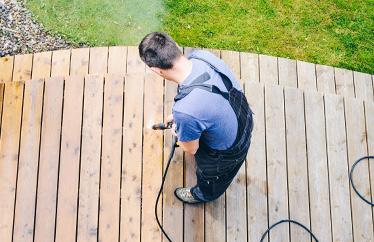Winter Home Maintenance Checklist for a Cozy Home in 2024

According to the Insurance Information Institute, winter storms accounted for nearly $6 billion in insured losses between 2013 - 2022. These losses turn into huge headaches for homeowners who experience home damages related to snow, ice, freezing, and flooding from these storms.
Maintaining your home for the winter season may not only help prevent these damages but can also save you money in the long run.
Follow our comprehensive winter home maintenance checklist as you prepare your home for the seasonal storm activity ahead. Prepare now to help prevent small issues from turning into big ones.
1. Suppress storm damage

If you live in an area prone to winter storms, your roof could take a beating during the winter from the heavy snow, ice, and potential flooding that come from them, setting you back financially from high repair costs.
Existing vulnerabilities, like damaged shingles or worn-out flashing, can lead to leaks. These leaks can wreak havoc in your home, causing water damage to walls, ceilings, and insulation. They can also contribute to the formation of ice dams, which further damage your roof and pose a safety hazard as ice can fall and cause injury.
Actions to take:
-
Regularly inspect your roof for damaged or missing shingles, cracked flashing, or deteriorated seals around vents, chimneys, and skylights. Use metal for the best durability and weather resistance when replacing flashing material. Silicone sealant also works great for deteriorated seals due to their weather resistance.
-
Insulate your attic by sealing air leaks. Use caulk and weatherstripping to seal gaps around pipes, vents, chimneys, and other openings. Focus on the attic floor and the ceiling of the floor below.
-
Verify that your attic insulation is in good condition and meets your region’s recommended R-values (resistance to heat flow). While there is a method and formula to measure this, we recommend consulting a qualified insulation contractor or energy auditor. They can provide the most accurate assessments through infrared thermography tools.
2. Clean gutters and downspouts
Gutters and downspouts work in unison to channel rainwater and melting snow away from your home's foundation, helping to prevent potential flooding, structural damage, and basement leaks. Neglecting their gutter cleaning and maintenance can lead to several costly and disruptive issues.
Actions to take:
-
Schedule regular gutter and downspout cleaning, especially in the fall when leaves are shedding. If doing it yourself, remove all debris, leaves, and twigs to improve water flow. Trowels and scoops get the job done here, but if you’d like extra clean gutters and downspouts, you can also flush residual debris with a garden hose.
-
Install guards or screens to help prevent debris from entering the gutters. These guards can help reduce cleaning frequency and simplify maintenance. Mesh gutter guards enable water flow but block debris like leaves and twigs.
-
Install heat cables or roof de-icing systems to help prevent the formation of ice dams. Proper insulation and attic ventilation can also help keep your roof cooler and reduce the risk of ice dams. Choose self-regulating heat cables to optimize your winter energy savings.
3. Clear walkways
Slip and fall hazards increase in the winter. While friends and family may be careful to avoid an accident on your property, other visitors may not be as familiar with your entryways.
If a visitor is injured in a fall on your property, your home insurance policy may have medical coverage limits between $1000 and $5000. Avoid putting yourself at risk and having to make a claim like this by keeping your walkways clear.
Actions to take:
-
Regularly shovel and de-ice walkways, driveways, and stairs to help prevent ice buildup and create safe paths for walking and driving. Use ice melt when you need to quickly melt ice, and use sand when you primarily need traction on icy surfaces. A combination of the two can work to melt ice and provide traction at the same time.
-
Rather than attempting to remove all the snow in one pass, shovel in layers. Start by clearing a thin layer of snow from the surface, then remove any remaining snow or ice. This technique prevents the accumulation of a heavy load of snow, making the task more manageable.
4. Prune your trees and bushes

While typical homeowners insurance may cover the damage of fallen trees, overgrown branches are a safety hazard during blizzards, which you should address as early as possible with dormant pruning to remove deadwood for the overall health of your trees and plants as well for preventing risks of branches falling.
Snow and ice can lead to falling branches, potentially damaging property, vehicles, or posing a danger to people in the vicinity.
Dense and overgrown vegetation can trap snow and ice, creating potential ice dams and increasing the load on branches and shrubs. Proper trimming helps reduce the risk of damage and improves the effectiveness of snow and ice removal.
Actions to take:
-
Inspect trees and bushes for branches that are weak, dead, or overhanging structures, walkways, or your home. For a deeper look into risky branches, try to find ones originating from a single point. These are codominant stems and are prone to splitting in the winter.
-
Trim branches close to your house, roof, and utility lines. For taller trees, pole pruners provide that extra reach and are most useful for trimming. Also note that it’s normally illegal to trim branches near utility lines, so contact your utility providers for assistance.
-
Consider hiring a professional tree service for large or complex trimming tasks, especially those involving tall trees or difficult-to-reach branches.
5. Prevent frozen pipes and other water damage

Frozen pipes can burst when they reach below-freezing temperatures which is a top reason for winter water damage.
One of the heaviest blows a home takes from a burst pipe is the structural damage to walls, ceilings, and floors. Water infiltration can also lead to electrical hazards where water-damaged wiring can cause fires and other malfunctions.
Actions to take:
-
Insulate pipes in unheated areas, such as crawl spaces, attics, and basements, using foam pipe insulation or heating tape. Pay special attention to pipes near exterior walls. Pipe insulation foam sleeves are easy to install and can accommodate various pipe diameters. For that extra moisture-resistant insulation, opt for fiberglass pipe wrapping.
-
Seal any gaps or cracks in the walls, floors, windows, or foundation that allow cold air to infiltrate areas where pipes are. Silicone caulk is a go-to material for sealing for its versatility, and you can cut the perfect length of weatherstripping adhesive for windows.
-
During very cold nights, leave a slow drip from indoor faucets connected to pipes vulnerable to freezing. The movement of water can help prevent freezing.
6. Check carbon monoxide detectors and fire extinguishers
Carbon monoxide incidents are most common in the winter when our home heating and cooking equipment burn fuels the most. Your CO detectors need to be working properly year round and especially in the winter time when we burn through fuel to keep warm. While many owners keep a fire extinguisher handy, they often go unchecked for years at a time.
Actions to take:
-
Change detector batteries annually, ideally before winter. Detector batteries typically are of the 9-volt or AA category. If your detectors are hardwired into your home’s electrical system, you may need to turn off the power to the detectors.
-
Check the detectors’ expiration date or life span, replacing them as needed.
-
Remember to install detectors and fire extinguishers on every level of the home, including the basement. Fire extinguishers should be serviced yearly.
7. Winterize your sump pump
A sump pump is a mechanical device typically installed in a basement or crawl space of a building. Its primary purpose is to prevent water from accumulating and flooding the lower areas of a structure.
Sump pumps can be prone to winter-related damage. The water in the sump pump pit can freeze which can immobilize the float switch, preventing it from turning on. Sump pumps have a discharge pipe that expels excess water. If this pipe freezes, it can’t do its job.
Actions to take:
-
Insulate the discharge pipe using foam pipe insulation or heat tape designed for this purpose. Make sure all exposed pipes are well covered.
-
Cover the sump pit with a lid or airtight cover. This helps prevent cold air from entering and freezing the water in the pit.
-
If your sump pump is in an unheated area, you can place insulation around it to help maintain a stable temperature. Use materials like foam board or fiberglass insulation.
8. Service heating systems and heat sources

The NFPA found that, from 2016 to 2020, home fires occurred the most in the winter months beginning in November and heating equipment was the second leading cause of house fires and house fire injuries in that time period. When your heat sources are unmaintained, you risk home fires from dust and debris accumulation, spark fires, clogged filters, and faulty and damaged parts.
Actions to take:
-
If you have disposable filters in your furnace or HVAC system, replace them with new ones. Make sure to use filters of the correct size and MERV rating. If you have washable filters, wash them according to the manufacturer's instructions and allow them to dry completely before reinstalling.
-
Replace heat exchangers, compressors, fans, and ducts in your furnaces and HVAC system according to manufacturer guidelines.
- Prevent spark fires from emitting from your fireplace by installing a spark guard on the opening.
9. Protect plants and outdoor spaces from freezing
While winter's frost may have you retreating indoors, you shouldn’t forget your outdoor spaces. Winterizing your garden and other outdoor areas will help preserve your hard gardening work and maintain outdoor furniture. Winterizing your garden protects plants from frost and freezing, and the longevity of your furniture, while designed to be weather resistant, will benefit further if stored away properly.
Actions to take:
-
Generously apply mulch to your garden floors to shield plant roots from the cold.
-
Cover delicate plants with frost cloth or burlap to help shield them from cold winds and frost. If you have movable potted plants, bring them indoors or place them in a sheltered area to prevent freezing.
-
Store or cover outdoor furniture to protect it from winter weather and prolong its durability. Polyester material with waterproof backing works well as furniture covers as they are both durable and weather resistant. Covers with drawstrings or tie-downs also help secure furniture in place.
10. Stock up on supplies for winter
Slippery roads and icy conditions can make it challenging to travel, so self-sufficiency is key in emergencies. Stock up on supplies like insulation to wrap pipes and provisions for home emergencies as well as food and emergency kit essentials.
Actions to take:
-
Regularly inspect your emergency kit and replace any expired items. Make sure it includes winter-specific essentials, like warm clothing, nonperishable food, water, flashlights, batteries, first aid kits, snow removal tools, and a backup power source.
-
If you have a vehicle, service it before winter to ensure it's in good working condition. Check tires, brakes, and antifreeze levels. You can also use your vehicle to store emergency essentials.
-
Compile a list of all your emergency contacts. Aside from local authorities, this should include your family, neighbors, and even your utility company.
Depending on the region, winter can be a harsh season for your home to endure both indoors and outdoors. While covering all your bases is challenging, our winter home checklist can help you prioritize your winter maintenance planning. Be proactive and prevent home-related damages this winter by downloading our Hippo Home app.
Download our winter home maintenance checklist
When maintaining your home there’s a lot to look for, especially in the wintertime. Depending on where you live, the severity of the winter weather may affect how you prioritize your home. Our Winter home maintenance checklist helps you keep track of your home’s needs. Have a look below.

Disclaimer:
YourHaus, Inc. ("Hippo Home") is an affiliate of Hippo Insurance Services. Services (including all repair or maintenance services) provided to customers through affiliated and unaffiliated third-party contractors. Your use of Hippo Home is subject to Hippo Home's terms and conditions and privacy policies. Use of unaffiliated third-party vendors is subject to the terms of service provided by such third party. Hippo Insurance Services is not responsible for your use/non-use of Hippo Home or any service vendor. @ YourHaus, Inc. 2023
Hippo Insurance Services ("Hippo") is a general agent for affiliated and non-affiliated insurance companies. Hippo is licensed as a property casualty insurance agency in all states in which products are offered. Availability and qualification for coverage, terms, rates, and discounts may vary by jurisdiction. We do not in any way imply that the materials on the site or products are available in jurisdictions in which we are not licensed to do business or that we are soliciting business in any such jurisdiction. Coverage under your insurance policy is subject to the terms and conditions of that policy. Coverage and coverage amounts selected are the decision of the buyer.
This guidance and advice is not error-proof and not applicable to every home. You are responsible for determining the proper course of action for your property and neither Hippo nor Hippo Home is responsible for any damages that occur as a result of any advice or guidance.




